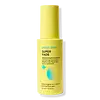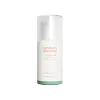What's inside
What's inside
 Key Ingredients
Key Ingredients

 Benefits
Benefits

 Ingredients Side-by-side
Ingredients Side-by-side

Water
Skin ConditioningPropanediol
SolventNiacinamide
SmoothingCetyl Tranexamate Mesylate
Skin Conditioning1,2-Hexanediol
Skin ConditioningGlycerin
HumectantAcetyl Glucosamine
Skin ConditioningCucumis Sativus Fruit Extract
EmollientGlycyrrhiza Glabra Root Extract
BleachingPanthenol
Skin ConditioningCamellia Sinensis Leaf Extract
AntimicrobialMadecassoside
AntioxidantAsiaticoside
AntioxidantMadecassic Acid
Skin ConditioningAsiatic Acid
Skin ConditioningKojic Acid
AntioxidantAllantoin
Skin ConditioningSalix Alba Bark Water
AstringentCalendula Officinalis Flower Extract
MaskingMalus Domestica Fruit Extract
AntioxidantCitrullus Lanatus Fruit Extract
Skin ConditioningLens Esculenta Fruit Extract
Skin ConditioningEuterpe Oleracea Fruit Extract
Butylene Glycol
HumectantSucrose
HumectantCeratonia Siliqua Gum
EmollientHydroxyethylcellulose
Emulsion StabilisingSodium Phytate
Caprylyl Glycol
EmollientEthylhexylglycerin
Skin ConditioningWater, Propanediol, Niacinamide, Cetyl Tranexamate Mesylate, 1,2-Hexanediol, Glycerin, Acetyl Glucosamine, Cucumis Sativus Fruit Extract, Glycyrrhiza Glabra Root Extract, Panthenol, Camellia Sinensis Leaf Extract, Madecassoside, Asiaticoside, Madecassic Acid, Asiatic Acid, Kojic Acid, Allantoin, Salix Alba Bark Water, Calendula Officinalis Flower Extract, Malus Domestica Fruit Extract, Citrullus Lanatus Fruit Extract, Lens Esculenta Fruit Extract, Euterpe Oleracea Fruit Extract, Butylene Glycol, Sucrose, Ceratonia Siliqua Gum, Hydroxyethylcellulose, Sodium Phytate, Caprylyl Glycol, Ethylhexylglycerin
Water
Skin ConditioningPropanediol
SolventNiacinamide 4%
SmoothingTranexamic Acid 4%
AstringentButylene Glycol
Humectant1,2-Hexanediol
Skin ConditioningPyrus Communis Fruit Extract
Skin ConditioningSodium Polyacryloyldimethyl Taurate
Emulsion StabilisingEthylhexylglycerin
Skin ConditioningPolyglyceryl-10 Laurate
Skin ConditioningMadecassoside
AntioxidantCentella Asiatica Extract
CleansingAsiaticoside
AntioxidantAscorbic Acid
AntioxidantAsiatic Acid
Skin ConditioningMadecassic Acid
Skin ConditioningSodium Ascorbyl Phosphate
AntioxidantWater, Propanediol, Niacinamide 4%, Tranexamic Acid 4%, Butylene Glycol, 1,2-Hexanediol, Pyrus Communis Fruit Extract, Sodium Polyacryloyldimethyl Taurate, Ethylhexylglycerin, Polyglyceryl-10 Laurate, Madecassoside, Centella Asiatica Extract, Asiaticoside, Ascorbic Acid, Asiatic Acid, Madecassic Acid, Sodium Ascorbyl Phosphate
 Reviews
Reviews

Ingredients Explained
These ingredients are found in both products.
Ingredients higher up in an ingredient list are typically present in a larger amount.
1,2-Hexanediol is a synthetic liquid and another multi-functional powerhouse.
It is a:
- Humectant, drawing moisture into the skin
- Emollient, helping to soften skin
- Solvent, dispersing and stabilizing formulas
- Preservative booster, enhancing the antimicrobial activity of other preservatives
Asiatic Acid is a major component of Centella Asiatica Extract. It has wound-healing, anti-inflammatory, and antioxidant properties.
Studies show Asiatic Acid is able to block the pathway for skin inflammation receptors, helping to soothe skin.
As an antioxidant, asiatic acid helps protect our skin against damaging environmental factors.
Learn more about Asiatic AcidAsiaticoside comes from the super popular skin-soothing ingredient, Centella asiatica. It is one of four active compounds found in the extract of Centella Asiatica.
Asiaticoside is an antioxidant and helps with wound healing. It has been shown to increase antioxidant activity during the wound healing process.
Butylene Glycol (or BG) is used within cosmetic products for a few different reasons:
Overall, Butylene Glycol is a safe and well-rounded ingredient that works well with other ingredients.
Though this ingredient works well with most skin types, some people with sensitive skin may experience a reaction such as allergic rashes, closed comedones, or itchiness.
Learn more about Butylene GlycolEthylhexylglycerin (we can't pronounce this either) is commonly used as a preservative and skin softener. It is derived from glyceryl.
You might see Ethylhexylglycerin often paired with other preservatives such as phenoxyethanol. Ethylhexylglycerin has been found to increase the effectiveness of these other preservatives.
Madecassic Acid is a major component of Centella Asiatica Extract. It has anti-inflammatory and antioxidant properties.
It is a triterpenoid, meaning it naturally acts as an antioxidant. Antioxidants protect your skin against damage from environmental factors such as pollution and UV.
Studies show Madecassic Acid helps soothe the skin due to its ability to block inflammation pathways.
Learn more about Madecassic AcidMadecassoside comes from the super popular skin-soothing ingredient, Centella asiatica. It is one of four active compounds found in the extract of Centella Asiatica.
Madecassoside has antioxidant, anti-inflammatory, and hydrating properties. It contains fatty acids, amino acids, beta-carotene, and phytochemicals.
One study found using Madecassoside with ascorbic acid helped reduce the signs of aging and improved skin hydration.
Learn more about MadecassosideNiacinamide is a multitasking form of vitamin B3 that strengthens the skin barrier, reduces pores and dark spots, regulates oil, and improves signs of aging.
And the best part? It's gentle and well-tolerated by most skin types, including sensitive and reactive skin.
You might have heard of "niacin flush", or the reddening of skin that causes itchiness. Niacinamide has not been found to cause this.
In very rare cases, some individuals may not be able to tolerate niacinamide at all or experience an allergic reaction to it.
If you are experiencing flaking, irritation, and dryness with this ingredient, be sure to double check all your products as this ingredient can be found in all categories of skincare.
When incorporating niacinamide into your routine, look out for concentration amounts. Typically, 5% niacinamide provides benefits such as fading dark spots. However, if you have sensitive skin, it is better to begin with a smaller concentration.
When you apply niacinamide to your skin, your body converts it into nicotinamide adenine dinucleotide (NAD). NAD is an essential coenzyme that is already found in your cells as "fuel" and powers countless biological processes.
In your skin, NAD helps repair cell damage, produce new healthy cells, support collagen production, strengthen the skin barrier, and fight environmental stressors (like UV and pollution).
Our natural NAD levels start to decline with age, leading to slower skin repair, visible aging, and a weaker skin barrier. By providing your skin niacinamide, you're recharging your skin's NAD levels. This leads to stronger, healthier, and younger looking skin.
Another name for vitamin B3 is nicotinamide. This vitamin is water-soluble and our bodies don't store it. We obtain Vitamin B3 from either food or skincare. Meat, fish, wheat, yeast, and leafy greens contain vitamin B3.
The type of niacinamide used in skincare is synthetically created.
Learn more about NiacinamidePropanediol is an all-star ingredient. It softens, hydrates, and smooths the skin.
It’s often used to:
Propanediol is not likely to cause sensitivity and considered safe to use. It is derived from corn or petroleum with a clear color and no scent.
Learn more about PropanediolWater. It's the most common cosmetic ingredient of all. You'll usually see it at the top of ingredient lists, meaning that it makes up the largest part of the product.
So why is it so popular? Water most often acts as a solvent - this means that it helps dissolve other ingredients into the formulation.
You'll also recognize water as that liquid we all need to stay alive. If you see this, drink a glass of water. Stay hydrated!
Learn more about Water